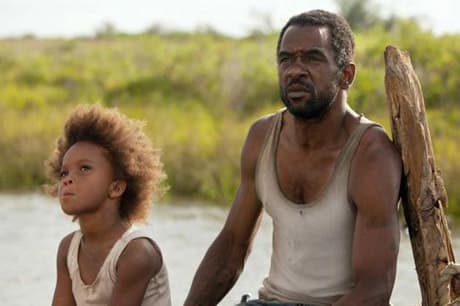Stripped to its narrative bones, removed from unique framing and stylistic sensibilities that uniquely blend realism and magic-realism into a terrifying yet dreamlike vision of survival, Beasts of the Southern Wild, in a sheer superficial summary, seems like little more than wet blanket, politically conscious pandering for those prone to sanctimony and issue attachment.
In telling the story of young Hushpuppy (Quvenzhané Wallis), a seven-year-old girl living adjacent to modern civilization in a remote, contextually dilapidated portion of the Louisiana bayou, when (presumably) Hurricane Katrina arrives, Benh Zeitlin's feature film debut hits the soapbox notes by blending a questionable lifestyle with terminal illness and even the effects of global warming on those outside of the spectrum of privilege.
Her quest is one of forced independence and learned savage impulses as she desperately seeks out her deceased mother, conscious of her father's impending mortality from an unnamed (but indirectly spelled out) illness. Setting fire to her ramshackle hut, which is littered with cardboard boxes and empty cans, she tests her relationship with her mercurial, distanced, yet strangely loyal father, making their inevitable efforts to maintain their lifestyle in the middle of a disaster scene, floating on a boat made out of a junked car, a fable about a man trying to teach his daughter how to get by in the world while he still can.
But what separates this visually specific and exceedingly thoughtful allegory and coming-of-age tale from the endless array of issue movies is Zeitlin's treatment of perspective and his narrative subjects. While we see and understand the horrors unfolding around Hushpuppy, our gaze is always filtered through her assessment of these details.
The bayou way of life – where teachers use casual profanity and children operate heavy machinery without supervision – is simply a matter-of-fact, quotidian presence, as is the visual metaphor of prehistoric creatures emerging from icebergs to challenge Hushpuppy, working as a symbolic representation of the unknown worldly horrors to come.
While unsentimental and ultimately jarring in its naive, childlike framing of death and premature existential crisis, the casual mixing of daydream whimsy and harsh reality creates a profound sensibility of its own. We're immersed in an unfamiliar environment and forced to tackle unflattering life realities from the perspective of innocence, which, in itself, is what makes this work a clever and remarkable achievement.
(eOne)In telling the story of young Hushpuppy (Quvenzhané Wallis), a seven-year-old girl living adjacent to modern civilization in a remote, contextually dilapidated portion of the Louisiana bayou, when (presumably) Hurricane Katrina arrives, Benh Zeitlin's feature film debut hits the soapbox notes by blending a questionable lifestyle with terminal illness and even the effects of global warming on those outside of the spectrum of privilege.
Her quest is one of forced independence and learned savage impulses as she desperately seeks out her deceased mother, conscious of her father's impending mortality from an unnamed (but indirectly spelled out) illness. Setting fire to her ramshackle hut, which is littered with cardboard boxes and empty cans, she tests her relationship with her mercurial, distanced, yet strangely loyal father, making their inevitable efforts to maintain their lifestyle in the middle of a disaster scene, floating on a boat made out of a junked car, a fable about a man trying to teach his daughter how to get by in the world while he still can.
But what separates this visually specific and exceedingly thoughtful allegory and coming-of-age tale from the endless array of issue movies is Zeitlin's treatment of perspective and his narrative subjects. While we see and understand the horrors unfolding around Hushpuppy, our gaze is always filtered through her assessment of these details.
The bayou way of life – where teachers use casual profanity and children operate heavy machinery without supervision – is simply a matter-of-fact, quotidian presence, as is the visual metaphor of prehistoric creatures emerging from icebergs to challenge Hushpuppy, working as a symbolic representation of the unknown worldly horrors to come.
While unsentimental and ultimately jarring in its naive, childlike framing of death and premature existential crisis, the casual mixing of daydream whimsy and harsh reality creates a profound sensibility of its own. We're immersed in an unfamiliar environment and forced to tackle unflattering life realities from the perspective of innocence, which, in itself, is what makes this work a clever and remarkable achievement.
